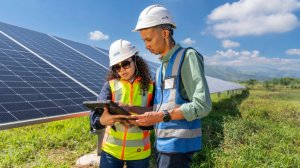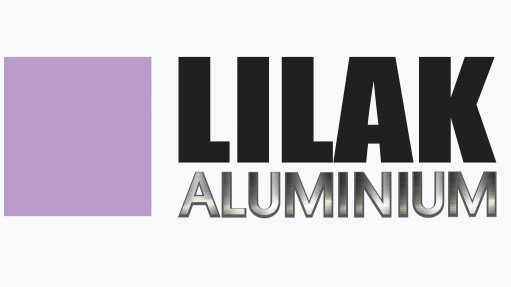Energy grid impedes excess power transmission



REACHING LIMITS According to JUWI with the introduction of large-scale solar and wind in the cape provinces, the power flow of the national electricity transmission infrastructure, is being reversed. The network was not designed to achieve this, resulting in the installed capacity reaching its limits
Photo by JUWI
REDUCING GRID CHALLENGES JUWI recently entered into an agreement with Teraco to utilize the capacity from one of its solar sites to wheel power to Teraco’s facilities across the country, with JUWI being appointed to design and manage the procurement, construction, and commissioning of the 129 MW solar PV plant
Photo by JUWI
South Africa’s current electricity transmission grid is generally constrained in the Cape provinces and unable to facilitate the connection of new utility-scale generation including that from solar photovoltaic (PV) and wind, says wind and solar energy facility developer JUWI Renewable Energies.
Historically, the majority of South Africa’s electricity supply was provided by coal power stations, the majority located in Mpumalanga, with the power transmitted to the major load centres including those in the Cape. The national transmission grid is still set up in this way, despite the introduction of large-scale renewables, as the cost and time to upgrade this infrastructure is onerous.
The best wind resources in the country are situated in the Cape provinces, and not only the expected coastal areas as there are “some fantastic areas” inland too. The country’s solar resource is more evenly spread out although the northwest areas of the country are the most favourable, notes JUWI.
“The national electricity transmission infrastructure that South Africa relies on was originally designed and built to cater for generation close to the major sources of fuel, namely coal, and the transmission to the major load centres; broadly-speaking this means power flows from the north-east to the south-west. However, with the introduction of large-scale solar and wind in the Cape provinces, this power flow is being reversed,” says JUWI project development head Chris Bellingham.
Bellingham explains that the network was not designed to achieve this and, given the designed line capacity and State-owned power utility Eskom’s current operational philosophy, the installed capacity has reached its limits.
Eskom’s operational philosophy follows an N-1 system, which is designed and operated to successfully manage the impact of a major failure of a single node within the respective transmission network. Therefore, should such a failure occur, then, ideally, the remaining nodes would deal with power flows, without there being a large disruption that could result in large-scale blackouts.
Bellingham points out that Eskom has also published an addendum to the Generation Connection Capacity Assessment Report published in October 2023, in which it details the location and extent of additional generation connection capacity in the Eastern and Western Cape under a ‘curtailment mechanism’.
Eskom transmission group executive Segomoco Scheppers stated if wind energy facilities accepted a “reasonable share” of curtailment, 3 470 MW of additional generation capacity could be connected to the grid “almost immediately”, with the possibility of adding 2 680 MW in the Western Cape and 790 MW in the Eastern Cape.
Bellingham comments that the implementation of curtailment should not be too onerous for both government-offtake wind power projects and new private offtake projects, but existing private power projects will have a far more significant problem.
“If this curtailment, which was not envisioned in their initial planning, is pushed onto private projects that have already achieved financial close, then having to factor in the non-reimbursed curtailment of up to 10% into the financial model could be challenging for those projects.”
Bellingham went further to caution that, “in order to meet the envisaged energy mix of the Integrated Resource Plan, we should take heed of key lessons learnt from the Cape grid constraints and consider reserving grid capacity in high wind resource areas for future wind projects. Particularly since the much shorter development timeframes of solar PV projects and their preference to be located adjacent to major transmission substations could hinder the ability for wind projects to obtain the land rights and grid connection capacity necessary to achieve realisation”.
Overcoming Grid Challenges
Prior to the Cape grid constraints, JUWI had developed 1500 MW of solar PV projects in the Northern Cape, across five clusters to a ‘ready-to-bid’ status. It recently entered into an agreement with data centre company Teraco to utilise the capacity from one of these sites to wheel power to Teraco’s facilities across the country. In addition, JUWI was appointed to design and manage the procurement, construction and commissioning of the facility.
“Initially, we had selected one of our Northern Cape sites that had both excellent energy resources and had a valid, relatively low-cost grid connection estimate from Eskom,” Bellingham says.
However, when JUWI entered into Eskom Budget Quote discussions covering the final grid-connection approval and pricing process, there no longer was sufficient connection capacity and the Cape networks had become constrained.
“We were fortunate to be able to successfully pivot to another fairly advanced site outside of the grid constraints, being developed by Subsolar, and for which we entered into a sales and development services agreement,” he recalls.
This Free State site will enable Teraco to connect its planned 120 MW solar facility to the national grid. The power generated will be pushed across Eskom and municipal power networks to Teraco’s facilities across South Africa.
In Teraco’s media announcement on February 21, 2024, Teraco CEO Jan Hnzido stated that the allocation of grid capacity to the site was a significant step towards meeting its renewable-energy ambitions and those of its clients.
Hnzido, at the time, commented that the project was the first phase of the company’s longer-term renewable-energy commitment, also noting that it had laboured over the past few years to obtain these allocation approvals, with the aim now to “execute quickly on the opportunity”.
Teraco sustainability head Bryce Allan added that, when fully operational, the 120 MW solar PV plant is estimated to produce more than 338 000 MWh yearly. He noted that the PV project represented a large component of Teraco’s plan to achieve its 100% clean energy goal.
Article Enquiry
Email Article
Save Article
Feedback
To advertise email advertising@creamermedia.co.za or click here
Comments
Press Office
Announcements
What's On
Subscribe to improve your user experience...
Option 1 (equivalent of R125 a month):
Receive a weekly copy of Creamer Media's Engineering News & Mining Weekly magazine
(print copy for those in South Africa and e-magazine for those outside of South Africa)
Receive daily email newsletters
Access to full search results
Access archive of magazine back copies
Access to Projects in Progress
Access to ONE Research Report of your choice in PDF format
Option 2 (equivalent of R375 a month):
All benefits from Option 1
PLUS
Access to Creamer Media's Research Channel Africa for ALL Research Reports, in PDF format, on various industrial and mining sectors
including Electricity; Water; Energy Transition; Hydrogen; Roads, Rail and Ports; Coal; Gold; Platinum; Battery Metals; etc.
Already a subscriber?
Forgotten your password?
Receive weekly copy of Creamer Media's Engineering News & Mining Weekly magazine (print copy for those in South Africa and e-magazine for those outside of South Africa)
➕
Recieve daily email newsletters
➕
Access to full search results
➕
Access archive of magazine back copies
➕
Access to Projects in Progress
➕
Access to ONE Research Report of your choice in PDF format
RESEARCH CHANNEL AFRICA
R4500 (equivalent of R375 a month)
SUBSCRIBEAll benefits from Option 1
➕
Access to Creamer Media's Research Channel Africa for ALL Research Reports on various industrial and mining sectors, in PDF format, including on:
Electricity
➕
Water
➕
Energy Transition
➕
Hydrogen
➕
Roads, Rail and Ports
➕
Coal
➕
Gold
➕
Platinum
➕
Battery Metals
➕
etc.
Receive all benefits from Option 1 or Option 2 delivered to numerous people at your company
➕
Multiple User names and Passwords for simultaneous log-ins
➕
Intranet integration access to all in your organisation
















